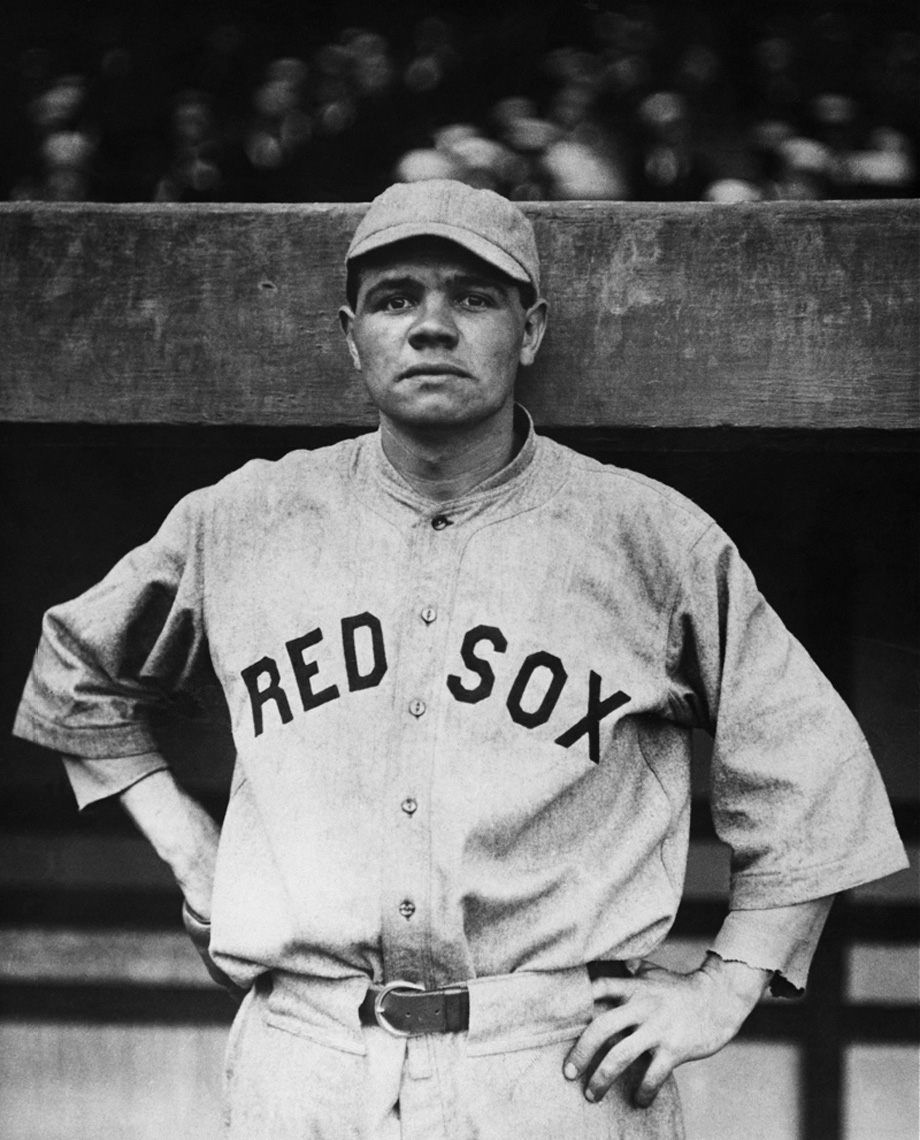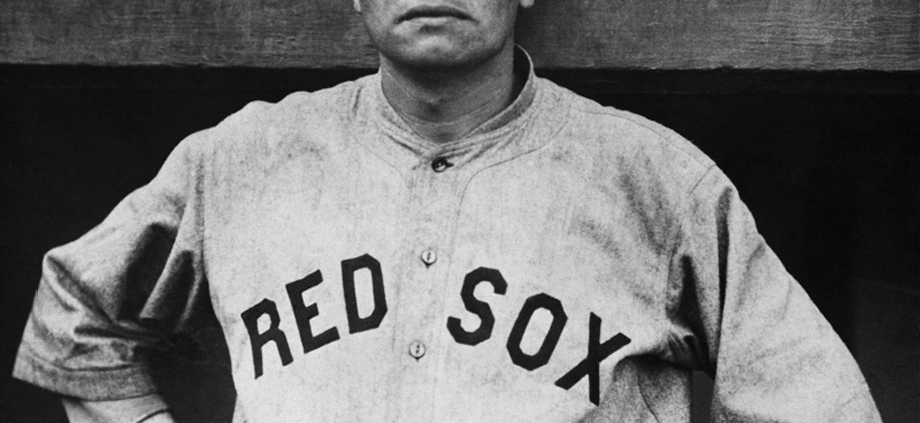May 15, 1919: Boston’s Babe Ruth pitches 11 innings of rocky relief for a win over White Sox
 It was still early in the 1919 season, one in which the Chicago White Sox won the American League pennant. The Boston Red Sox – World Series champions from the year before – were headed for sixth place, percentage points behind the fifth-place St. Louis Browns, 20½ games back. Indeed, a “Sox” team had won each of the last four World Series – the Red Sox in 1915, 1916, and 1918, and the White Sox in 1917.
It was still early in the 1919 season, one in which the Chicago White Sox won the American League pennant. The Boston Red Sox – World Series champions from the year before – were headed for sixth place, percentage points behind the fifth-place St. Louis Browns, 20½ games back. Indeed, a “Sox” team had won each of the last four World Series – the Red Sox in 1915, 1916, and 1918, and the White Sox in 1917.
In the months after the 1919 season wrapped up, both teams’ fortunes changed significantly. The White Sox became infamous as the “Black Sox” because eight of their players were banned for life for allegedly conspiring with gamblers to fix games in the World Series. The Red Sox sold their preeminent player – Babe Ruth – to the rival New York Yankees. As it happened, neither franchise won its next World Series championship until the twenty-first century. The Red Sox snapped their 86-season drought in 2004, and the White Sox ended their 88-season wait a season later in 2005.
In a Thursday afternoon game in May in Chicago, though, both still-unsullied teams went head-to-head. The Red Sox won – but only after Babe Ruth pitched 11 innings of relief.
Ruth had become a beloved star in Boston. He led the AL with nine shutouts and a 1.75 ERA in 1916 and had a 23-12 won-lost record. He was 24-13 in 1917. In 1918, when he began to play in the outfield and first base, he still went 13-7 as a pitcher. He was 3-0 in three World Series starts and had a combined ERA of 0.87. He could hit, too, leading the league in home runs in both 1918 and (as it transpired) in 1919.
Just the day before, on May 14, the White Sox had beaten the Red Sox, 1-0, a game that began a streak of three consecutive shutouts and 29 2/3 scoreless innings for Chicago’s Eddie Cicotte.1
Ruth wasn’t Boston’s starting pitcher in the May 15 game. That honor went to Bullet Joe Bush, who’d been 15-15 (with a 2.11 ERA) for the Red Sox in 1918, but was making his first appearance of the 1919 season, in Boston’s 13th game.
First-year White Sox manager Kid Gleason’s starter was Lefty Williams. He fell behind quickly after right fielder Harry Hooper’s leadoff double down the left-field line, a sacrifice by second baseman Jack Barry, an RBI double to left by center fielder Amos Strunk, and a run-scoring single through the box by Red Sox left fielder Del Gainer.2 The Red Sox had a chance to add to their 2-0 lead after first baseman Stuffy McInnis singled, but third baseman Ossie Vitt flied out to left, and McInnis, running on contact, was called out for neglecting to retouch second as he tried to return to first.3
In the bottom of the first, Bush faced three White Sox batters and retired all three. He grounded out to end Boston’s scoreless second inning, and then didn’t return to the mound – his right shoulder was not up to the task.
As the Boston Globe reported, Bush “found that his wing was in no shape to continue, and the game paused while Babe Ruth was hurried into action.”4 Indeed, Red Sox manager Ed Barrow brought Ruth into the game to take over pitching. Ruth, who had gone 0-for-4 with two strikeouts a day earlier against Cicotte while playing left field, had pitched only once so far in 1919: a complete-game win over the Yankees on May 3.
Ruth walked the first batter – Shoeless Joe Jackson – but got a fly-ball out and a double play to end the inning.
In the third, Barry reached on an infield single and then nearly scored – but was thrown out at the plate on what was scored a triple to right-center by Gainer. In the home half of the inning, Ruth again walked one batter – Williams – but the White Sox once more failed to score.
The Red Sox upped their lead to 4-0 in the top of the fourth. They loaded the bases with nobody out on a single by McInnis, a fielding error by Chicago shortstop Swede Risberg, and a bunt single toward third by Everett Scott. Gleason called on 25-year-old left-hander Dickey Kerr to relieve Williams. It was just Kerr’s fifth game in the majors.
Kerr hit the first batter he faced, catcher Wally Schang. That forced in a run. Babe Ruth was up with the bases loaded – but struck out. Hooper grounded out, short to first, and the fourth run scored. Kerr got Barry to ground out, too.
The White Sox began to rally in the bottom of the fourth. Third baseman Buck Weaver doubled to left to lead off the inning. Second baseman Eddie Collins singled to right and drove in Weaver. Jackson hit a ball right back to Ruth, who started a 1-6-3 double play.
There were no further runs in the fourth, but the White Sox tied it up, 4-4, by producing three more runs in the bottom of the fifth.
Ruth was not at his best. A base on balls, a single, and a walk to Kerr loaded the bases with nobody out. Shano Collins grounded out to McInnis, but a run scored. After Weaver flied out, Eddie Collins reached, squeezing out a run-producing infield single. With Jackson at the plate, the White Sox pulled off a double steal.5 Collins stole second, and Kerr stole home after reversing course when third baseman Scott could not handle catcher Schang’s throw. The game was tied.
The sixth was scoreless, but Boston regained the lead in the top of the seventh. Risberg committed his second error of the game, misplaying a ball hit by Ruth, who was advanced to second by Hooper’s sacrifice. Barry singled to center, but saw Ruth cut down at home plate by Happy Felsch’s throw. Barry took second on the throw home, then scored as Strunk singled to short left-center, making it a 5-4 game.
Ruth allowed a single in the seventh, and two more in the eighth, but he took the one-run lead to the ninth. Catcher Ray Schalk led off with a single. He was sacrificed to second by pinch-hitter Fred McMullin, batting for Kerr. Shano Collins made the second out, but Buck Weaver doubled to the left-field flagpole, tying the game, 5-5. Ruth retired Eddie Collins to send it to extra innings.
Frank Shellenback was Chicago’s new pitcher. Neither team scored in either the 10th or the 11th, though both teams saw two batters reach base in the 10th, the Red Sox got one man on in the 11th, and the White Sox got a single and double in the 11th, putting runners on second and third with just one out. Ruth got Eddie Collins to hit a foul popup and Jackson to fly out to left.
In the top of the 12th, Barry led off with a single. Strunk dutifully laid down a sacrifice. Gainer then hit the ball back to Shellenback, who threw to third to prevent Barry from advancing. Barry scooted back to second, but Gainer had kept running, and there were two Red Sox on second base. Gainer was ruled out.
But McInnis bailed out his teammates’ baserunning misadventure by swinging at the first pitch and doubled to right field. Barry scored, giving the Red Sox a 6-5 lead.
Ruth walked Felsch leading off the bottom of the 12th, but he retired the next three batters and got his second win of the season, despite giving up five runs. He hadn’t been at his best, walking eight White Sox batters and striking out none.
As Burt Whitman wrote in the Boston Herald, “He just barely managed to wobble through, but he had fairly good defence behind him in times of greatest stress. … Babe was not the best pitching Babe of other years. He was wild and he was not particularly fast and his curve ball did not behave … [y]et he won the game, even if he once had a lead of 4 to 0.”6
Ruth had been 0-for-4 at the plate – “very bad, the worst he has appeared this season. But everyone else on the team got at least one hit.”7 And his team had won. He had worked 11 innings of relief, tying the Red Sox team record set by Ted Lewis back on July 27. 1901, that one also in Chicago, and that time a win for the White Sox. It’s a record that still holds, more than a century later.8
Acknowledgments
This article was fact-checked by Larry DeFillipo and copy-edited by Len Levin.
Photo credit: Babe Ruth, Library of Congress.
Sources
In addition to the sources cited in the Notes, the author consulted Baseball-Reference.com and Retrosheet.org.
https://www.baseball-reference.com/boxes/CHA/CHA191905150.shtml
https://www.retrosheet.org/boxesetc/1919/B05150CHA1919.htm
Notes
1 See Jacob Pomrenke, “May 14, 1919: Chicago’s Eddie Cicotte begins scoreless streak by shutting out Red Sox, 1-0,” SABR Games Project at https://sabr.org/gamesproj/game/may-14-1919-chicagos-eddie-cicotte-begins-scoreless-streak-shutting-out-red-sox-1-0 . All in the same homestand, Cicotte shut out Philadelphia on May 18, also 1-0, and then the Yankees on May 23, 5-0.
2 Gainer was playing left field instead of Ruth, who customarily played left in 1919. It had been something of a day off for Ruth – before he got called on to pitch.
3 I.E. Sanborn, “Sox Lose Most Spectacular Game in Years to Boston, 6 to 5,” Chicago Tribune, May 16, 1919: 13.
4 “Red Sox Victors in 12-Inning Struggle,” Boston Globe, May 16, 1919: 9. Bush appeared in only one more game in 1919, on July 4, when he threw six innings but had to give up the attempt. He returned to baseball in 1920 and won 15 games for the Red Sox that year and 16 the next, but then was himself dealt to the Yankees. His 26-7 record led the league in winning percentage in 1921.
5 Chicago was fortunate to still have Jackson in the game, In the top of the fifth, he had collided hard with the wall to the bleachers, catching and holding onto Gainer’s drive, but at first seeming to have been knocked unconscious.
6 Burt Whitman, “Champions Whip Chisox in 12-Inning Classic,” Boston Herald, May 16, 1919: 16.
7 Whitman.
8 Ruth returned to the mound five days later, on May 20, and pitched a complete game to beat the St. Louis Browns. He also connected on his first of 16 career grand slams in that game. Ruth set a major-league record with 29 homers in 1919, while going 9-5 with a 2.97 ERA as a pitcher.
Additional Stats
Boston Red Sox 6
Chicago White Sox 5
12 innings
Comiskey Park
Chicago, IL
Box Score + PBP:
Corrections? Additions?
If you can help us improve this game story, contact us.


